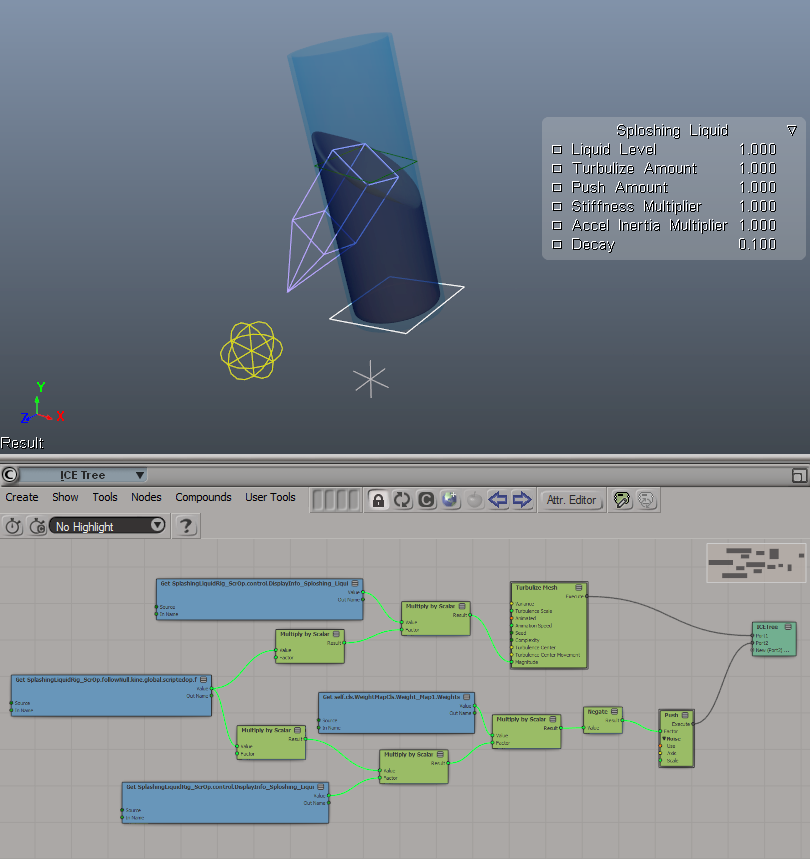Dynamic Sloshing Liquid Rig. Making It Look Like a Simulation With Nothing but the Awesome Power of Math. Part 1: The Basic Rig
Check this out:
Looks delicious, doesn't it?
What you see here is not a result of a fluid simulation. It's a combination of Linear Algebra and some neat mesh manipulation tricks to make the surface deform and behave as if it were a small body of water in a container reacting to being thrown around a scene, sloshing and splashing back and fourth.
This is what you call a rig. A "sloshing liquid rig" as I decided to name it. Intended to be used in a couple of scenes of the animated short film I'm working on.

This bad boy will save me so much time when I get to animating liquids for background objects.
Let's now dive in and see what's happening under the hood. There's some math involved, but be not afraid: as always, I will try to make it as entertaining as possible and visualize everything along the way.
Navie Effex Dynamics And Simulation Framework For Cinema4D Now Free
While the year 2018 may have started with a large meltdown for the rest of the world, we, the 3D folk are still getting some great news following my previous blog post. This time it's Effex by Navie (formerly DPit Nature Spirit) - a fast and robust Particles & Fluid Simulation framework for C4D which went free recently. Effex comes with lots of goodies including an excellent FLIP solver I think I'm in love with.
It can do lots of stuff. See for yourselves:
Anyway, just grab a copy from GitHub.
Although the fact that such great products go free makes me uneasy for some reason. Can't stop thinking about the developers. Hopefully they are ok and not doing this due to problems selling the product...
Mootzoid Plugins for Softimage, C4D, Maya and Modo Now Available For Free!
What an amazing NY2017 present from Mootzoid for all of Softimage/XSI zealots out there (and for Maya/C4D/Modo guys to some extent as well)!
Quoting Eric: "For the upcoming holidays I wanted to let you know that as of today all my plugins are available for free on my website www.mootzoid.com. Just download any plugin and you're ready to go without any license hassle and without making your wallet unhappy :)"

Plugins are available at Eric's website, as usual.
Can't wait to get my hands on the full versions of emFluid and emPolygonizer!
BTW, you know what makes Eric's plugins so special? Just a couple examples:
- They add complete OpenVDB support (read/write) inside Softimage! You can simulate fire and smoke whilst exporting frames to .VDB whilst having Redshift for example picking those frames to render. It's fast and it's reliable.
- emPolygonizer provides a powerful multithreaded mesher to use with any object, be it particles or just a bunch of meshes. I used a while ago to mesh hundreds of thousands of particles in my FleX Fluid Simulation studies and was thoroughly impressed. It is so, so much more powerful than XSI's native polygonizer.
Thank you, Eric!
Nvidia Physx Flex and Other Fluid Solvers for High-Quality Fluid Simulation
 Beware the strawberry milkshake monster!
Beware the strawberry milkshake monster!
Simulations are hard.
When it comes to doing simulations on meshes with a finite number of vertices it's relatively easy to achieve desired results. But as soon as you try taming hundreds of thousands or even millions of particles, you're in trouble. Especially when it comes to doing fluid simulations. You need a special kind of solver, a powerful rig or a network of rigs and a lot of patience. It took me by surprise how difficult seemingly trivial simulations can be.
In the animated film I'm working on I will have bodies of water large and small and certain gaseous liquids in the background for increased production value.
If you're a freelancer or a hobbyist on a budget in need to simulate some fluids, off-the-shelf tools available on the market can be a good choice... But there are so many of them that finding out their differences as well as pros and cons is a quest in itself. In this post I'll explore some of the ways an amateur like me can do various fluid-like simulations and what technologies there are to help get the job done.
The big guns
I'll briefly cover two of perhaps the most well known and renowned fluid sims on the market - Naiad and Realflow.

There was the time when you could only purchase a single Naiad license for 5500$ or rent it quarterly for about 1400$. Luckily those times are over since in 2012 Naiad was sold over to Autodesk and turned into Maya Bifrost. So now you can get your hands on Naiad tech within maya for just $185 a month. You can find out more about Bifrost in this blog post at Digitaltutors. It's a powerful FLIP solver (more on this method below) and well integrated into Maya too with GPU caching and an ability to playback tens of thousands or even millions of particles in real-time directly within the DCC as well as a variety of tools for artistic direction of your simulations.

Then there's Realflow, which comes with several solvers for you to choose (SPH, PBF, HYBRIDO) and with its Dyverso particle solver (the one which uses PBF) gives you the ability to simulate on CPU or GPU, the latter using OpenCL for computations. You can read more about Realflow's solvers here. Overall, Realflow isn't terribly slow and well scalable when you give it lots of cores to work with, but as soon as you realize your hardware limitations and the fact that the cheapest single-seat license with the C4D integration costs over 750 bucks you start looking for other solutions.
Other freeware and commercial tools for fluid simulation
I won't spend too much time on different types of solvers available on the market, only mention some of them for the sake of argument. There's an excellent (albeit slightly dated) article on the subject at fxguide explaining them in detail if you're interested in finding out more.
High-Quality Cloth Simulation With Nvidia Physx Flex (Also Softimage Ice)
This is the first post demonstrating what NVIDIA PhysX FleX is capable of when it comes to high-quality simulations. I'm planning to show how it can be used for all kinds of simulations with the upcoming blog posts. Also a cool demonstration video below.
What is FleX?

FleX is a particle based simulation framework developed by NVIDIA for real-time visual effects. The idea is the following: instead of a having a bunch of solvers for each type of a body (rigid, soft, fluid, cloth e.t.c.) why not create a unified solver based on the concept of using particles (or “molecules” if you prefer) to represent the bodies? Then, make this solver work on modern GPUs to deliver unprecedented simulation speed and you can actually use the result for real-time simulations in games or interactive presentations.

Now, we all know what “real-time performance” means when it comes to the “offline” CGI... ;)
Using Cloth Simulation and Delta Mush Deformer for Skin Collision in Animation
I'd like to present the results of a study I conducted recently:
Story
Working on the animated short film I am constantly updating a list of tasks to do in order to achieve a descent final result. One particular topic took my sleep away recently when I remembered that in order to correct skinning errors on animated characters you'd either have to sculpt and then script a bunch of blend shapes or would need a muscle system available in your DCC software.
I then turned to Maya, which has had a muscle system for ages.
Maya Muscle system
Maya provides several deformers to manage soft- and hard-tissue interaction between muscles like smart-, self- and multi-object collisions. Even though they aren't terribly performant, they get the job done.

Unfortunately as soon as I would've used any of Maya's Muscle system tools I'd be tied down to a 185$ a month subscription plan for the whole duration of the project which would be outrageous. There is a lite-version of Maya available for indie gamedevs — Maya LT — which only costs 30$ a month, but it doesn't come with the Muscle system.

Hence I had to improvise and develop a simple and straightforward solution for this problem in a DCC of my choice.